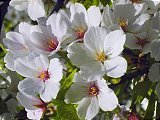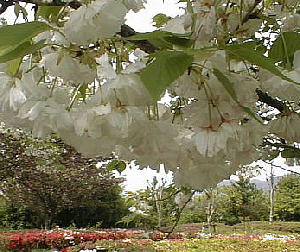
 |
|
|
||||
|
Sakura (Cherry Blossoms) -
03-15-2007, 08:16 AM
After briefly scanning through the various forums and threads, I've discovered that there aren't any threads on one of Japan's most beautiful traditional festivals, the cherry blossom O.o
According to my research, sakura basically means cherry blossom itself, hence the name. The cherry blossom (sakura) is Japan's unofficial national flower. It has been celebrated for many centuries and takes a very prominent position in Japanese culture. How it all began: Japan is often referred to as the land of flowers. From ancient times the people of Japan have celebrated the Cherry Blossom Festival as O-hanami: Flower Viewing. Although many beautiful flowers are depicted in song, paintings and even kimono patterns, flower viewing has always meant the beautiful flowering cherry tree  In the eighth century and earlier, the Japanese offered prayers while under the flowering cherry trees in a special ritual for the fertility of the earth. The Hitachinokuni Fudoki, an eighth century guide to famous places, describes singing and dancing among the flowers after climbing Mount Tsukuba. During the Heian period the imperial court held a banquet on the day of O-hanami to mark the change of seasons. Later in the Kamakura period (late 12th-14th c.), the warriors always considered the cherry blossoms the symbol of a life lived fully, no matter how short, and the ritual of cherry blossoms continued In the eighth century and earlier, the Japanese offered prayers while under the flowering cherry trees in a special ritual for the fertility of the earth. The Hitachinokuni Fudoki, an eighth century guide to famous places, describes singing and dancing among the flowers after climbing Mount Tsukuba. During the Heian period the imperial court held a banquet on the day of O-hanami to mark the change of seasons. Later in the Kamakura period (late 12th-14th c.), the warriors always considered the cherry blossoms the symbol of a life lived fully, no matter how short, and the ritual of cherry blossoms continued  Flower viewing in the Edo period (17th-19th c.) became a popular secular event among the common people, with much dancing, singing and drinking of sake. And today Japanese radio and television announce the Sakura Zensen or Cherry Blossom front, allowing revelers to travel from region to region, following the blooming trees. Usually, the Cherry Blossom front begins in Okinawa in the south in March. Then it sweeps northward in April and finally reaches Hokkaido in May. With more than 50 varieties blooming from March to May, the excitement mounts XD~! Millions of visitors travel to famous temples, gardens and scenic spots. Dance and music concerts feature the cherry blossom and celebrate spring with poetry competitions, calligraphy exhibits, and paintings that depict the viewing season. Picnics are also planned under the flowers by schools, companies and families to celebrate the short fleeting bloom of this popular symbol of Japan  When Japanese people immigrated to the Untied States in the late 19th century, they planted the flowering cherry trees wherever they lived. In 1911, the Japanese government sent thousands of cherry trees to Washington D.C. which were planted all around the Washington Tidal Basin. This gesture of friendship between the two countries began the first Sakura Matsuri or Cherry Blossom Festival in the United States. Other Cherry Blossom festivals are held throughout the country in Macon, Georgia; Tuscalossa, Alabama; Detroit, Michigan; San Francisco, California; and Brooklyn, New York. It is obviously a symbolic event that brings countries and people together. Seattle’s Cherry Blossom Festival began when one thousand Cherry trees were sent by the Japanese government  The trees were planted along Lake Washington Boulevard and Seward Park. The Seattle area is fortunate in the abundance of Japanese cherry trees it has in the parks and other public places. The Seattle Center, the Arboretum, the Japanese Garden, the University of Washington, Woodland Park, and the Seattle Buddhist Church Wysteria Plaza also have Japanese cherry trees. Arthur Lee Jacobs' "Trees of Seattle," tells you exactly where they are. You can have your own O-hanami (flower viewing) and then join the crowd at the Cherry Blossom & Japanese Cultural Festival The trees were planted along Lake Washington Boulevard and Seward Park. The Seattle area is fortunate in the abundance of Japanese cherry trees it has in the parks and other public places. The Seattle Center, the Arboretum, the Japanese Garden, the University of Washington, Woodland Park, and the Seattle Buddhist Church Wysteria Plaza also have Japanese cherry trees. Arthur Lee Jacobs' "Trees of Seattle," tells you exactly where they are. You can have your own O-hanami (flower viewing) and then join the crowd at the Cherry Blossom & Japanese Cultural Festival  This is just one of the many delights you'll be able to pleasurably experience while living in Japan.   For more details, you can visit: Cherry Blossom Festival - Japanese Cherry Blossoms P.S. This thread is dedicated to all the older JF'ers: Avary_Ninja, Kainpendragon, CrimsonNataku, maks, Vesperd, kudo, Ash, GuitarisutoKao, etc etc, and especially to NinjaKasumi123 ^_^ Of course, the rest of the members are also welcome to visit this thread whenever you want =P Enjoy!!! XD There's no such thing as happy endings, for when you find true love, happiness is everlasting.
|
|
||||
|
03-15-2007, 08:47 AM
There are many dozens of different cherry tree varieties in Japan, most of which bloom for just a couple of days in spring. The Japanese celebrate that time of the year with hanami (cherry blossom viewing) parties under the blooming trees.
A large majority of cherry trees in Japan are of the Somei Yoshino and Yamazakura varieties. But in total, over one hundred cherry tree varieties can be found in Japan. There are several characteristics that differ between the various cherry tree varieties. Some of the obvious ones, that can also be easily recognized by beginners, are listed below: Number of petals: Most wild trees, but also a lot of cultivated tree varieties have blossoms with five petals. However, some species have blossoms which consist of more than five petals, such as ten, twenty or more. Trees with blossoms of more than five petals are called yaezakura.  5 petals (e.g. Oshimazakura)  about 20 petals (e.g. Ichiyo)  about 100 petals (e.g. Kikuzakura) Color of the blossoms: Most varieties produce lightly pink to pure white blossoms, but there are also cherry trees with dark pink or slightly yellowish blossoms. The color of the blossoms of some varieties is also changing while they are in bloom, from white to pink, for instance.  white blossoms (e.g. Shogetsu)  pink blossoms (e.g. Kanzan) yellowish blossoms (e.g. Ukon) The fresh leaves: In case of early blooming trees, the fresh leaves usually do not appear until after full bloom, which gives the trees an attractive, homogenous look while they are in full bloom. In case of later blooming trees, the leaves usually appear before the blossoms, giving the trees a more heterogeneous look. Furthermore, the color of the fresh leaves differs between the varieties. In most cases, the fresh leaves are green, coppery brownish or something in between. Time of blooming: Most cherry tree varieties carry blossoms in spring. However, there are a few varieties, which bloom in late autumn and during the winter months. Yaezakura, i.e. cherry trees with blossoms of more than five petals, are typically the last ones to open their blossoms, about two to four weeks after most five-petaled species. Form of the tree: Cherry trees display various growing habits and come in different shapes and forms: triangular, columnar, V-shaped, weeping, flat-topped, etc. Weeping cherry trees are called shidarezakura. There's no such thing as happy endings, for when you find true love, happiness is everlasting.
|
|
||||
|
03-15-2007, 09:18 AM
Some cherry tree varieties, found in Japan, are listed below. The blooming periods (B.P) shown refers to the situation in Tokyo.
 Somei Yoshino (Yoshino Cherry) B.P: late March, early April Cultivated during the Edo Period, the Somei Yoshino is by far the most numerous cherry tree in Japan. Somei Yoshino trees come with slightly pink, almost white, 5-petaled blossoms.  Yamazakura B.P: late March, early April Yamazakura is a wild, native cherry tree variety of Japan, which typically grows in mountainous areas. The blossoms are slightly pink and have five, relatively small petals.  Shidarezakura (Weeping Cherry) B.P: late March, early April Shidarezakura are weeping cherry trees, i.e. they have drooping branches. There are trees with blossoms of five petals and trees with blossoms of more than five petals. The latter are called Yaeshidarezakura.  Ichiyo B.P: mid April The Ichiyo has about twenty, lightly pink petals per blossom. The fresh leaves are green.  Ukon B.P: mid April The Ukon has about 10-20 petals per blossom and coppery leaves. Ukon trees are easily recognized by their blossoms' characteristic, yellowish color. There's no such thing as happy endings, for when you find true love, happiness is everlasting.
|
|
||||
|
03-15-2007, 09:19 AM
Kanzan
B.P: mid to late April Among the many yaezakura varieties, the Kanzan is one of the most numerous. One Kanzan blossom consists of as many as 30-50 pink petals. The fresh leaves are coppery brown.  Fugenzo B.P: mid to late April The Fugenzo is a late blooming yaezakura with about 30-40 petals per blossom. White to slightly pink when they open, the blossoms turn into a darker pink over time. The fresh leaves are coppery brown.  Shogetsu B.P: mid to late April The Shogetsu is a late blooming yaezakura with relatively large, white blossoms of about 20-30 petals. The fresh leaves are green.  Kikuzakura (Chrysanthemum Cherry) B.P: late April, early May The Kikuzakura has as many as one hundred petals per blossom! It is also one of the latest blooming trees. In fact, by the time the blossoms are in bloom, the fresh leaves would have already developed almost completely and would somewhat be hiding the blossoms.  There's no such thing as happy endings, for when you find true love, happiness is everlasting.
|
|
||||
|
03-15-2007, 10:16 AM
 Don't mention it, Kasumi-chan ^_^ It was totally worth it Don't mention it, Kasumi-chan ^_^ It was totally worth it  Pity I don't have the ability to distinguish colors that well... >_<" wow, great images btw!  P.S. is the first one a cake? XD~! There's no such thing as happy endings, for when you find true love, happiness is everlasting.
|
|
||||
|
03-15-2007, 01:37 PM
I've compiled some of the pics Ive taken during Hanami
 and other pics of Kansai area as well.. and other pics of Kansai area as well.. Flickr: Photos from samokan |
|
||||
|
CoolNard: Wow, impressive! You must have put an extrodinary amount of time and effort into this. Just what JF needs - dedicated people.
 Also, good to know I'm not the only one capable of writing eye-bleeding posts.  Lol, jk jk. Lol, jk jk.  Samokan: Thanks for sharing your pictures, they're wonderful! You've just reminded me of why I want to visit Japan so dearly.  ~annelie |
 |
| Thread Tools | |
|
|